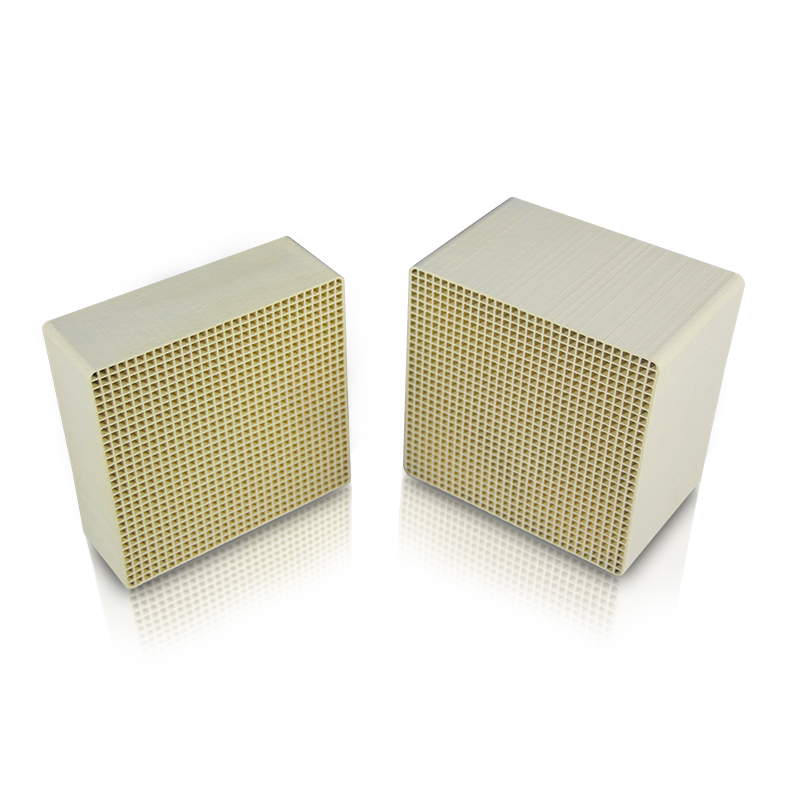The direction of denitrification catalyst development in the steel industry
Dec 07, 2022At present, according to the different forms of sinter configuration, the post-DSR denitrification processes are: wet desulphurisation + electrostatic dehumidification + GGH + hot air furnace + SCR, semi-dry desulphurisation + cloth bag dust removal + GGH + hot air furnace + SCR, activated carbon desulphurisation and dust removal + SCR denitrification. The pre-DGD denitrification process is mainly electrostatic precipitation + GGH + hot blast furnace + SCR + desulphurisation.

I Wet desulphurisation + electrostatic dehumidification + GGH + hot blast furnace + SCR
After the flue gas has been wet desulphurised and electrostatically dehumidified, the temperature is about 50-60°C. The low temperature flue gas is warmed up by heat exchange between GGH and the high temperature flue gas from the SCR outlet, then mixed with the high temperature flue gas from the hot air furnace and warmed up to 220-280°C to enter the SCR reactor, and the denitrification flue gas is cooled down by GGH and discharged. This process route requires the flue gas after wet desulphurisation to be raised from 50-60°C to 220-280°C, using a low temperature catalyst that is a little on the expensive side. For sintering machines, often with flue gas volumes in the millions of cubic metres, larger GGH heat exchangers need to be designed as well as 30-40°C heating energy consumption for the combustion gas, so investment costs and operating costs are high. However, this process route can meet ultra-clean emissions and is operationally stable, so even though the process has high investment and operating costs, it is still recommended.
2 Semi-dry desulphurisation + bag filter + GGH + hot blast furnace + SCR
After semi-dry desulphurisation and bag filtering, the flue gas temperature is about 120°C. The low temperature flue gas is warmed up by heat exchange between the GGH and the high temperature flue gas from the SCR outlet, then mixed with the high temperature flue gas from the hot air furnace and warmed up to 180-250°C to enter the SCR reactor, and the denitrification flue gas is cooled down to the GGH and discharged. This process route also uses a low temperature catalyst which is on the expensive side and is suitable for sintering machines with semi-dry desulphurisation. The flue gas is already relatively clean after semi-dry desulphurisation and dust removal, and is also the recommended process route as it can meet ultra-clean emissions and operate stably after warming up and then denitrification. However, as the semi-dry method uses alkaline substances to absorb sulphur dioxide, which are generally hygroscopic and lead to sticking and slaking, there is a risk that the filter bags of the bag filter or the ash hopper may slake, affecting the stable operation of the system.
3 Activated carbon desulphurisation and dust removal + SCR denitrification
As the activated carbon method cannot meet the ultra-low emission requirements for NOx and particulate matter removal, many enterprises now refer to the wet and semi-dry desulphurisation and dust removal + SCR denitrification process and choose to add SCR denitrification after the activated carbon unit, the denitrification temperature can be designed at 150-200°C, but the sintered flue gas can only be controlled at a concentration of about 15-20mg/Nm³ after activated carbon dedusting. The activated carbon method is a fully dry method, which is not as efficient in capturing alkali metals as the wet and semi-dry methods, and the alkali metal content in the fly ash after activated carbon dedusting is as high as 30-50wt%. At the same time, the flue gas passing through the activated carbon unit carries carbon dust and ammonium bisulphate/ammonium sulphate to the subsequent denitration unit. With the synergistic effect of alkali metals, carbon powder and ammonium bisulphate/ammonium sulphate, the risk of alkali metal poisoning deactivation and blockage of the catalyst remains high after a long period of accumulation, even with soot concentrations as low as 15-20mg/Nm3, which places higher demands on the design of the catalyst, a process that can also operate stably if paired with a suitable catalyst.
4 Electrostatic precipitation + GGH + hot blast furnace + SCR + desulphurisation
This process route is carried out prior to desulphurisation and uses a relatively alkali-resistant medium temperature catalyst. The flue gas coming out of the sinter is electrostatically de-dusted to a temperature of about 130°C, then heated up to above 300°C by the GGH and hot air furnace and fed into the SCR reactor. The denitrification flue gas is cooled down to 160°C by the GGH and sent to the desulphurisation tower, and the desulphurised flue gas is discharged through the chimney. This method is relatively cheap due to the use of medium temperature section catalysts, which are less expensive, but because the sintering machine ash contains 30-50wt% alkali metals, the catalyst is required to have strong resistance to alkali metal poisoning. In particular, the electrostatic precipitator equipped with the sintering machine does not capture the dust very well and often the ash content after dust removal is still as high as 100mg/Nm³. This high alkali, high viscous ash poses a certain risk of blockage and poisoning to SCR operation.
With the development of the world's scientific and economic integration, the importance of having independent intellectual property rights in the market competition is increasing day by day. The research on flue gas denitrification technology in China was carried out relatively late, and the early denitrification catalyst formulations and production lines were purchased from foreign technology, resulting in high production costs and expensive denitrification catalysts. Much of the technological innovation was based on the "import-absorb-reintroduce" model. However, the nature of flue gas varies greatly from industry to industry, and the introduced denitrification catalyst formulations and technologies can only be used for specific working conditions of flue gas. The core technology and intellectual property rights are restricted in every way, which seriously hinders innovation and development.